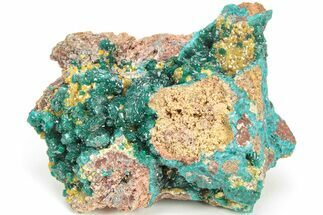1.3" Glassy Quartz Crystals & Cerussite over Plancheite - Sanda, Congo
This is a beautiful cluster of glassy quartz crystals and cerussite that formed over aggregations of sky-blue to deep blue plancheite, collected from the Sanda Hills occurrences (Sanda mine) in the Republic of the Congo. This mine has been closed since 2019, so this material is old stock. The entire specimen is 1.3" wide and is accompanied by mineral tack and an acrylic display base.
Cerussite is a lead-carbonate mineral with the chemical formula PbCO3, and is an important ore of lead. It is a common weathering product of galena, explaining why it is typically extracted from oxidized zones of lead ore deposits. It can form into a variety of different structures, sometimes in fibrous patterns and other times in granular aggregations, though it generally forms vitreous pseudo-hexagonal crystals. Its colors vary depending on composition and structure: it is most commonly colorless, white, grey and green-tinted.
Plancheite is a rare, hydrated copper silicate mineral that is typically found in oxidized copper deposits. It is a colorful mineral with a silky luster that can range in color from pale blue to deep blue or pale greenish blue, often forming fibrous or compact radial aggregates in association with other secondary copper minerals (chrysocolla, dioptase, malachite, shattuckite, and brochantite).
Plancheite is named after François Gilbert Planche, a French industrialist, politician, and director of the French Congo Mining Company. Planche provided the original samples of plancheite for study.
Chemical formula: Cu₈Si₈O₂₂(OH)₄
Plancheite is named after François Gilbert Planche, a French industrialist, politician, and director of the French Congo Mining Company. Planche provided the original samples of plancheite for study.
Chemical formula: Cu₈Si₈O₂₂(OH)₄
About Quartz
Quartz is the name given to silicon dioxide (SiO2) and is the second most abundant mineral in the Earth's crust. Quartz crystals generally grow in silica-rich environments--usually igneous rocks or hydrothermal environments like geothermal waters--at temperatures between 100°C and 450°C, and usually under very high pressure. In either case, crystals will precipitate as temperatures cool, just as ice gradually forms when water freezes. Quartz veins are formed when open fissures are filled with hot water during the closing stages of mountain formation: these veins can be hundreds of millions of years old.
Quartz is the name given to silicon dioxide (SiO2) and is the second most abundant mineral in the Earth's crust. Quartz crystals generally grow in silica-rich environments--usually igneous rocks or hydrothermal environments like geothermal waters--at temperatures between 100°C and 450°C, and usually under very high pressure. In either case, crystals will precipitate as temperatures cool, just as ice gradually forms when water freezes. Quartz veins are formed when open fissures are filled with hot water during the closing stages of mountain formation: these veins can be hundreds of millions of years old.
$25
SPECIES
Quartz, Cerussite & Plancheite
LOCATION
Sanda Hills Occurrences, Mindouli, Mindouli District, Pool Department, Republic of the Congo
SIZE
1.3 x 1"
CATEGORY
ITEM
#312435
 Reviews
Reviews









